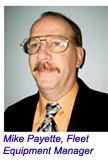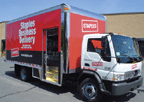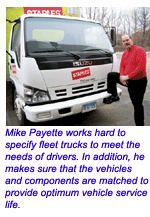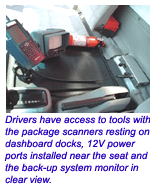A 30-year veteran of the fleet business, Mike Payette has seen it all – and keeps coming back for more. Freely admitting that he gets up everyday looking forward to the challenges of the job, Payette has served in many roles over the years, including as a technician and driver, and in maintenance, terminal, dispatch and safety operations.

For the past eight years, Payette has been fleet equipment manager for Staples Inc., the Framingham, Mass.-based leading seller of office products. Under his direction and supervision are more than 830 trucks fielded by the North American Delivery segment of the operation. The fleet makes deliveries to large corporate customers, smaller commercial businesses and private home offices ranging in size from a single desk to national accounts with hundreds of U.S. locations. Since many customers require next-day delivery, the fleet plays a critical role in helping Staples deliver on its promise to make buying office products easy.
The Staples North American delivery fleet includes approximately 740 primary delivery vehicles made up of Isuzu NPR, NQR and NRR HD models rated 14,500, 17,950 and 19,500 lbs. GVW. Some of the vehicles are equipped with 2,500- and 3,000-lb. capacity liftgates and all have 16- and 18-ft. Morgan bodies. About 80 secondary delivery vehicles in the fleet consist of International 4300 and Freightliner M2 Business Class 25,500-lb. GVWR models with 3,300- or 4,400-lb. liftgates and Morgan 24-ft. bodies. The fleet also includes 12 Freightliner and Dodge 3500 Sprinter models with 12-ft. high capacity bodies.
The sole person at Staples with fleet equipment responsibilities, Payette develops all vehicle specifications and manages programs for installation and removal of graphics and decals, works with chassis and body manufacturers, and negotiates all lease, maintenance, fuel and washing contracts. He also is responsible for uniform and cell phone programs and works closely with the company’s safety group to investigate driver injuries and alter specs to reduce their occurrence.
Growing intelligently
“Our fleet needs to grow intelligently,” Payette says. “Bi-annually, Staples conducts a lease versus buy analysis, taking into account the cost of money, residual values and end-of-life disposal options. Staples moved away from full-service leasing in 2003 in favor of finance leasing and outsourced maintenance agreements. Vehicle specifications focus on building a properly designed truck so it can be leased over a longer period of time, resulting in lower monthly costs and higher residual values.

“The type of vehicle and its specs determine the appropriate life cycle under a finance lease program for us,” Payette says. “The fleet is standardized by model year and order cycles. Currently, we run Sprinters and Isuzus for six years and Internationals and Freightliners for seven years. When mileage is computed, this seems to be the best life cycle to reduce high maintenance cost exposure and realize the highest residual value.
“We do not retrofit existing trucks with new spec alterations,” Payette says. “Standardization is important as we move trucks from route to route in a terminal and from terminal to terminal as needed to meet customer volume, and to equalize mileage. Drivers need to know that every truck will be configured as close as possible to what they have been operating.”
Assisting development
Staples also works closely with suppliers to investigate new technologies and components for potential use. “By partnering with suppliers, we can assist in development and test ideas in a real working environment,” he says. “That way, the true use of the component is reflected in its design.”
Currently, diesel-electric hybrids are one focus of those efforts.
“Isuzu has working models in Japan and we have actively petitioned the OEM to strongly consider providing Staples with a few of these units in our weight class for real-world testing,” Payette says. “We have also expressed a similar interest to International and Eaton for a hybrid system in the CF 500 and 600 cab and chassis. The powertrain in the CF series is the same one that was introduced as a hybrid in the Workhorse W62 chassis, so the match seems like a natural. “
The effort by Staples to explore new technologies and new applications for existing products has led to several special specifications for the Staples fleet. For example, working with lighting manufacturers led to the adoption of LED interior and exterior lighting on trucks.
“We spec Truck-Lite LED interior lighting on a 30-minute timer to prevent lights from being left on overnight and eliminate the need for jump starting” Payette says. “The LEDs also provide a much brighter blue/white light that makes labels easier to read. Our LED exterior lights include Grote flush mount models on rear side frames to avoid damage from pallets striking them during loading. In all cases, LEDs draw much lower amperage, produce no heat and have a 100,000-hour maintenance free bulb life.”

One change made to the Isuzu trucks in the Staples fleet for 2007 is the addition of an auxiliary 33-gallon fuel tank on the driver’s side of the vehicles.
“By moving from a 14,500-lb. chassis to 17,950- and 19,500-lb models we were easily able to carry the extra weight,” Payette says. “We had found that trucks were being fueled every day or every other day because the single 30-gallon tank didn’t allow for much range. By adding the extra tank, we more than doubled fuel capacity to 63 gallons so drivers now stop half as often as they used to.
“The real cost savings from this decision comes from the labor time while a driver goes off-route, stops at a fuel location, exits the trucks, pumps the fuel, does the paperwork, restarts the trucks and gets back out on the route,” Payette says. “This is an average of 22 minutes each time. With retail fuel pumps handling 20 gallons a minute and commercial pumps at 40 gallons a minute, the extra fuel pumped for the additional capacity only adds about 60 to 90 seconds, and only half as often. On average, the extra tank pays for itself in saved labor in just 40 weeks.”
Aluminum roof panels also are standard on Staples trucks. Previously, translucent composite roofs were specified, but the fleet found they increased interior body temperatures by an average of 14 degrees and were more susceptible to cracking from snow load and impacts.
Morgan Body specs for the Staples fleet also include Maximizer sliding side doors to allow easier access and egress from the vehicle, which reduces injuries from jumping off the rear of a truck. Anti-skid paint also is applied to steps and an 18-in. Chicago style rear bumper with two center steps allows drivers to more safely climb into and out of the rear body. A special cover is put in place over the steps when the truck is at a loading dock to allow drivers to more safely walk in and out of the vehicle.
Staples delivery truck interiors receive considerable attention as well. For example, forward compartments for chair mats, bulletin and white boards are in place to protect products from damage. In addition, there are large fixed shelves on the roadside to allow freight to be properly zoned and make better use of vertical cube space, while hinged shelves on the curbside can be folded up to allow larger items like file cabinets to be safely transported. Furthermore, wood strapping on the floor under the shelves keeps boxes leaning toward the wall and in place, as well as off the floor to protect them from water damage.
Safety and productivity are addressed in the specifications as well. For instance, a locked down center seat has a large aluminum utility tray fastened over it and secured to the floor. The tray holds a hand- held driver package scanner base and there are two 12V power ports installed at the rear of tray to plug in cell phone chargers and the scanners. In some trucks, the tray also houses the color flat screen monitor for the rearview back-up system. Installed on the rear door frame header, the camera – equipped with infrared sensors for use in complete darkness – is credited with eliminating backing accidents and allowing drivers to more safely back up to a loading belt at a terminal.
Using expertise
Having closely addressed specification issues, Staples decided to outsource all maintenance.
“In-house service operations do not make financial sense for us given the current fleet size at each terminal,” Payette says. “Instead, we utilize the services of large national providers like Ryder and Penske. We also use their expertise and history with specific models to assist in spec’ing trucks for low life cycle maintenance costs, including accessing data from their in-house computerized management information systems.”
Staples also depends on the negotiating strength of its maintenance providers to purchase parts and maintenance items for its vehicles. That includes replacement tires through national programs as well as handling issues related to warranties. In some cases, according to Payette, the fleet has been able to secure warranty consideration directly from manufacturers even after coverage has expired because of the maintenance provider’s strong relationship with the OEM.

Staples utilizes the services of its maintenance providers to secure fuel at negotiated rates. In some locations, mobile fueling services are employed.
“We are also seriously considering above ground bulk storage tanks for terminals that meet minimum requirements in terms of fleet size and local regulations,” Payette says. “Given that diesel or diesel-electric hybrids are the engines we’ll be using for the foreseeable future, our ability to purchase biodiesel in bulk will reduce our fuel costs.”
Improving fuel economy and reducing harmful emissions are important to Staples, a company Payette says takes its environmental stewardship very seriously. For example, the fleet has now set all engine electronic control modules to allow a top speed of 60 MPH.
“That not only improves fuel economy greatly,” he says, “but also it reduces CO2 emissions and positively impacts our maintenance costs.”
From spec’ing effectively to maintenance to fuel economy and safety, Staples leaves no stone unturned.
“We partner with our suppliers and rely heavily on those relationships to help ensure the success of our fleet operation,” Payette says.
Considering his extensive background and experience, suppliers undoubtedly also are looking to Staples and to Payette to help provide some of the answers as well. FE
SUPER SUCCESS
It started with a broken printer ribbon. It was the Fourth-of-July weekend in 1985 and Tom Stemberg, a former supermarket chain executive turned entrepreneur, was printing a business plan when his ribbon broke. Stemberg’s regular supplier, a local stationery store, was closed for the holiday. After driving from store to store and not finding his ribbon, he seized on an opportunity. Ten months later, on May 1, 1986, Staples opened the first office supply superstore in Brighton, Mass.
Since then, Staples has grown considerably. In 2006, company sales were $18.2 billion and there were 74,000 associates in its North American and growing international business segments. North American Retail operates 1,620 stores throughout the United States and Canada that offer more than 7,000 office products. North American Delivery consists of Staples Contract, Staples Business Delivery and Quill. Staples Contract serves mid–sized companies through Staples Business Advantage and Fortune 1000 companies through Staples National Advantage, working with customers to efficiently manage procurement programs for the lowest total delivered cost.
Staples Business Delivery is a unified selling channel that combines Staples.com and Staples’ catalog businesses to serve small to medium-sized businesses. Staples operates 30 fulfillment centers and its fleet of delivery trucks for this part of the operation. Quill Corp. is an office supplies direct marketer based in Lincolnshire, Ill., which was acquired by Staples in 1998. Quill and Quill.com, which operate as a separate brand serving small- to medium-sized business customers, are well known in industries such as the legal, medical and educational professions.
